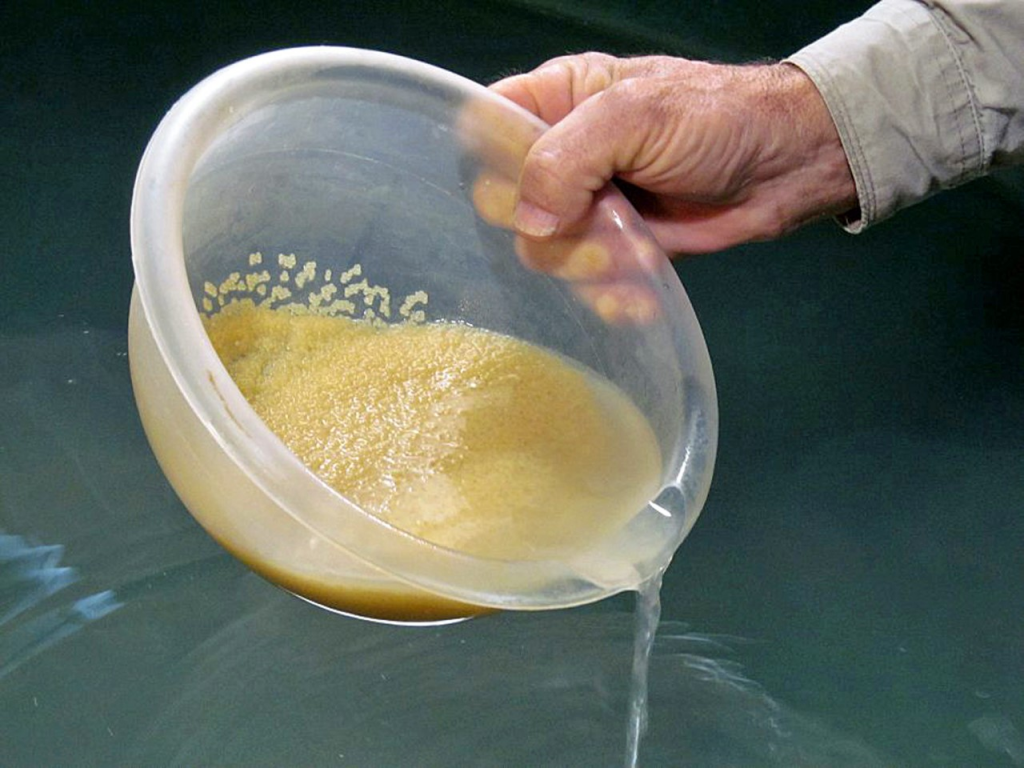
Features
Breeding
Education
Restocking
Education a highlight at Mississippi hatchery
May 14, 2021 By Julia Hollister
 Walleye eggs are placed in a bowl with water to remove adhesiveness. (Photo: North Mississippi Fish Hatchery)
Walleye eggs are placed in a bowl with water to remove adhesiveness. (Photo: North Mississippi Fish Hatchery) The North Mississippi Fish Hatchery brings aquatic discovery to the forefront of education and entertainment with fun interactive exhibits, native habit area and a10,000-gallon aquarium.
Sitting on 58 acres leased from the Army Corps of Engineers near Jackson, Mississippi, is the first and only facility of its kind in the state. The Visitor Education Center hosts tours and programs designed for students of all abilities and grades, from preschool to college level.
The Center promotes the sport of freshwater fishing in Mississippi and encourages the conservation and stewardship of aquatic resources. Educational outreach efforts include public seminars and workshops, statewide youth art contests, teacher workshops, youth fishing rodeos, online lesson plans, the World Record White Crappie – weighting 5 lbs. – and more. The Education Center also provides guided and self-guided tours for the public.
Variety of species
The hatchery stocks around 2 million fish in the Mississippi River annually.
Cool and warm-water species includes northern largemouth bass, southern walleye, (yes, there are walleye in Mississippi), paddlefish, alligator gar, white crappie, black crappie, Magnolia crappie, grass carp, bluegill, and red ear sunfish.
“The hatching process is different for each species,” says hatchery manager Cole Cochran. “For example, for the Gulf Coast walleye we go out and collect brood fish at night using gill nets. The fish are brought back to hatchery where they are sorted as to males and females. The females are then checked to determine the stage of egg development.”
The females are separated into groups accordingly by egg development stages and are injected with hormone to induce spawning, if necessary. No hormones are administered for fish that are close to being ripe; but they will be monitored closely until they are free flowing with eggs. They will be anesthetized with MS-222 and the eggs will be stripped from the females and fertilized with the sperm from two or three “lucky” males.
“We stir the eggs in a bowl of water and fullers earth to remove the adhesiveness from the eggs and stir using a turkey feather,” Cochran explains. “Next, the eggs go into McDonald hatching jars (These jars are the standard of the industry – a clear, high-impact, all-plastic egg hatching system.) The eggs remain in the jars until they hatch and swim over the top of the hatching jar into an aquarium. They are stocked into rearing ponds when they develop mouth parts.”
The fish will stay in the rearing ponds for about 30 days and then they are harvested and stocked in the public waters of the Mississippi.
The process is different for species such as Northern Largemouth bass.
The brood fish are kept onsite and moved from a pond into an 80-foot raceway to spawn on coconut fiber mats. Once they have spawned, they are moved inside the hatchery and suspended in tanks until the eggs hatch. The fry will remain in the tank until they begin to swim up from the bottom of the tank and are termed “swim-up fry.”
The fry are stocked into rearing ponds for around 30 days then harvested from the ponds and stocked into the public waters of Mississippi.
It’s a different “kettle of fish” for the White Crappie brood fish.
“Eggs are collected from reservoirs using an electrofishing boat and brought back to the hatchery to be strip spawned,” Cochran said. “These fish are anesthetized using electrosedation and the eggs from the females are stripped into a bowl with the sperm from a male. The eggs are stirred in a salt and urea solution, boiled in tannic acid to remove the adhesiveness and then placed in the hatching jars. Once the fry hatch they are collected and stocked into the rearing ponds until fall.”
Shad and similar fish are collected as adults using an electrofishing boat and brought back to the hatchery and stocked into rearing ponds where they will spawn naturally.
The tank room is a big attraction and a multi-use facility: treating sick fish, growing fish and holding fish for spawning. The process usually begins in the spring and ends in the fall when the fish go to stock.
In the wet lab, Cochran and his team will look at egg and fry development, prepare hormone injections, prepare any chemical mixtures needed for fish culture, and store fish tagging equipment. The incubation jars aerate the eggs until they hatch. Fish go into the rearing tanks, with an automatic feeder to grow and mature before insertion in the ponds.
Fish will be graded in the same size range as they grow. This size separation will keep the fish from eating each other. Once the desired size is reached they will be either moved to the rearing ponds or stocked in the public waters.
Print this page
Advertisement
- RAS Connector Series teams up with Denmark
- Canadian seafood mogul calls for ‘debate’ on salmon farming





